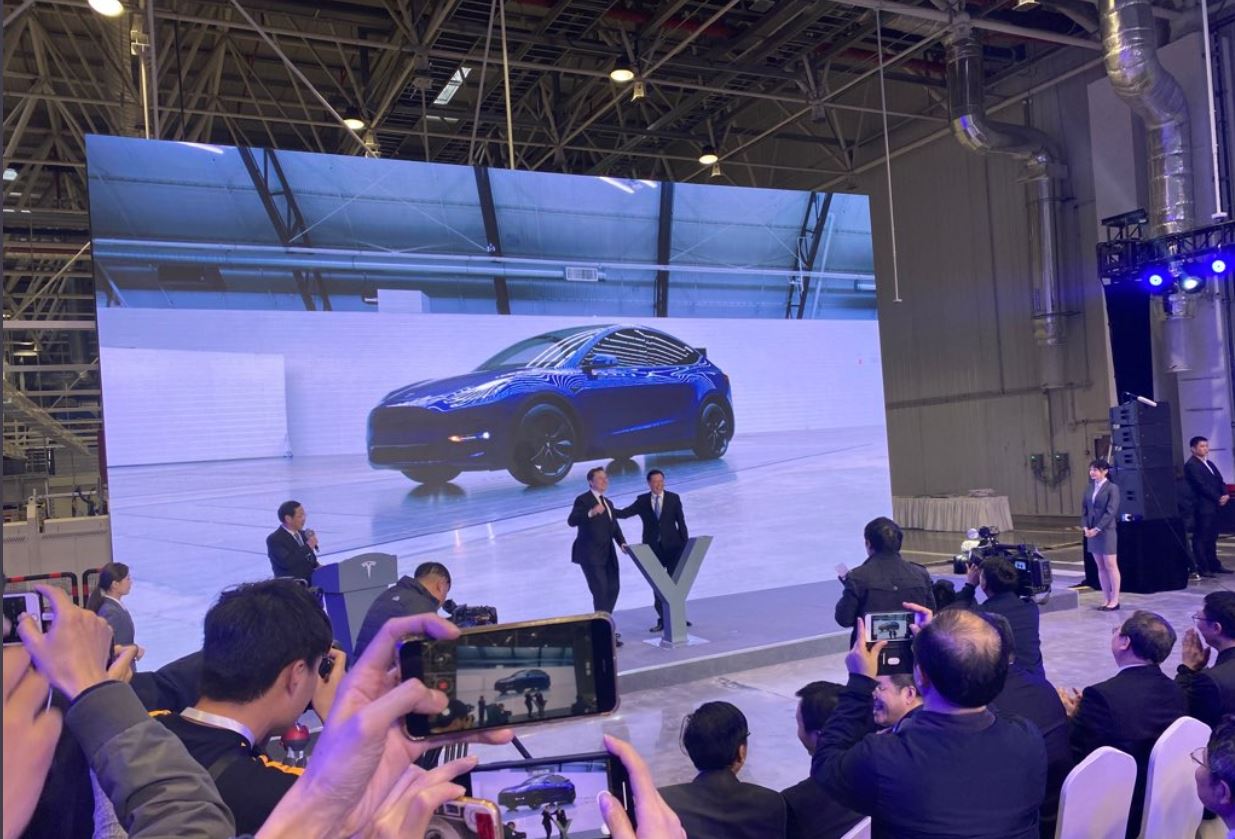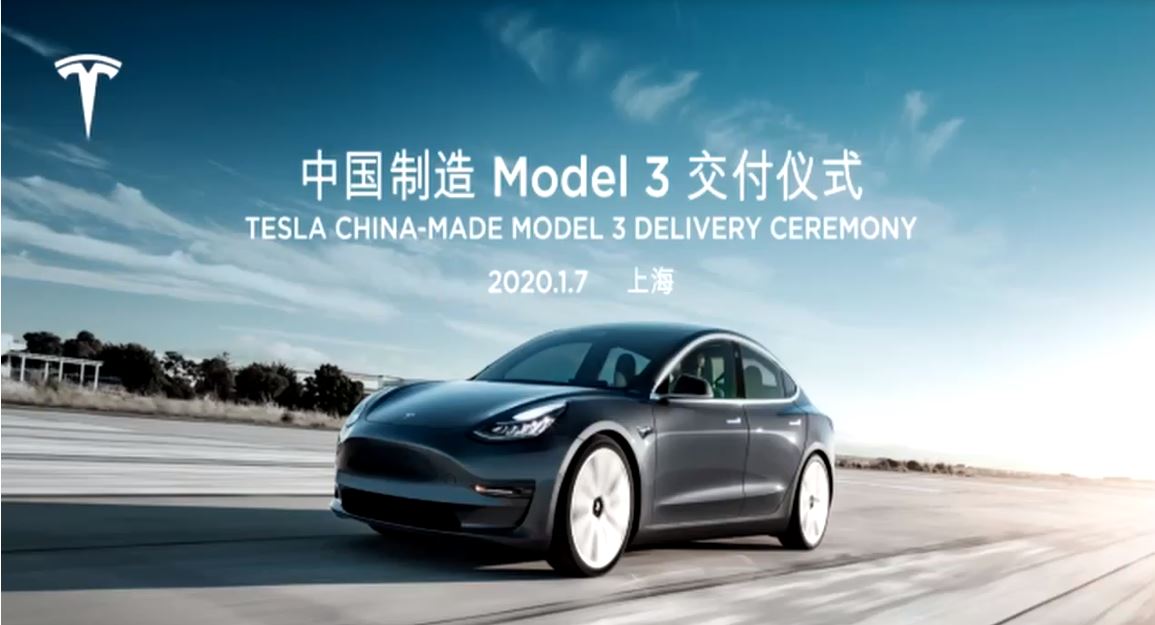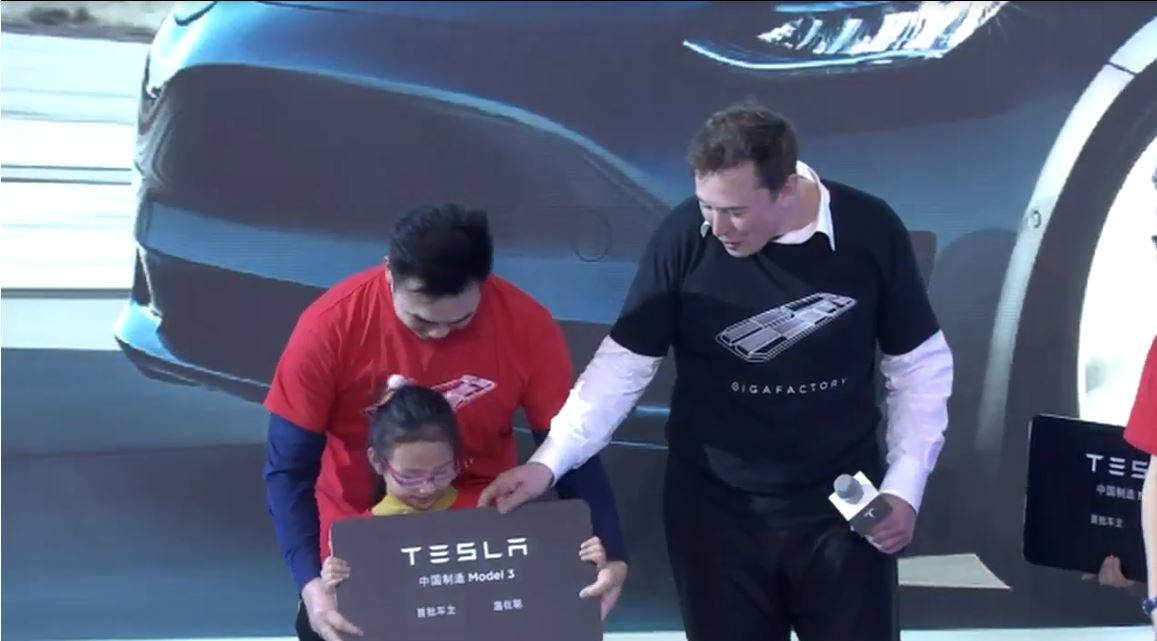

News
Tesla starts Model 3 customer deliveries in China, formally launches Model Y program
Tesla officially opened the floodgates in China as it made its first mass delivery of locally-made Model 3 on Tuesday during an event at Gigafactory 3 in Shanghai. The electric car maker also announced the kick-off of its Model Y program in the country.
CEO Elon Musk flew in from the United States to personally hand over Made-in-China Model 3s to the first local customers. This is a big milestone for Tesla as the MIC Model 3s are the first units delivered by Tesla’s first factory outside of the United States.
“Ultimately Model Y will have more demand than probably all of the other Tesla cars combined. Model Y will also have advanced manufacturing technologies that we will reveal in the future,” Musk said.
Musk also expressed his gratitude to the Chinese government, the Tesla China team, and all of the customers in the country. At one point during the ceremonies, Musk even showed some dance moves and emphasized how the company knows how to have fun despite all the work that needs to be done. Musk also did not forget to thank the early adopters who paid a premium to own their Teslas.
During a speech at the event, the Tesla chief also disclosed plans to have a Tesla engineering center in China that will design vehicles for the local market and the rest of the globe.
With the kick-off of the Model Y program in China, Tesla now has a powerful one-two punch combination that can potentially deal heavy blows to other automotive giants operating in the country. The Model 3 sedans will attract those looking for an entry-level electric vehicle while the Model Y will appeal to those looking for an all-electric crossover that offers more space at a practical price.
Tesla will be facing no pushovers in the local market. Daimler has released the Mercedes-Benz EQC in China and sells it for about $83,100 while Audi has rolled out the e-tron in late 2019 and plans to introduce more green vehicles in the next 24 months. BMW is also planning to join the EV rumble with its iX3 crossover next year.
The first public MIC Model delivery event happened exactly one year after the first wholly-owned car factory by a foreigner in China broke ground. Gigafactory 3 achieved the amazing feat of producing its first vehicles in just 10 months and making a symbolic delivery to local Tesla employees before the end of 2019.
Meanwhile, the production of the Model Y alongside the Model 3 will not be an issue for Tesla since these vehicles share 75% of their parts. Tesla also started accepting Model Y orders a few days ago, an early indication that the electric car maker is ready for this move.
Earlier this week, Tesla confirmed that Gigafactory 3 has achieved a run-rate of 3,000 vehicles per week to meet Model 3 demand in China. The government has also been very supportive and has exempted the locally-made sedan from a 10% purchase tax as announced recently.
Shanghai-based analysts are optimistic with their forecast for Tesla in China. Managing director of consultancy firm AutoForesight Yale Zhang sees the Palo Alto, California-based electric vehicle manufacturer selling around 100,000 MIC Model 3s while China International Capital’s Wang Lei sees around 120,000 combined sales of Model 3 and Model Y.
With the Model 3 and Model Y entering the largest automotive market in the globe, Tesla can become a strong foothold for the brand as it aims to achieve sustained profitability.
Here’s are some snapshots from the event:





Elon Musk
SpaceX issues statement on Starship V3 Booster 18 anomaly
The incident unfolded during gas-system pressure testing at the company’s Massey facility in Starbase, Texas.

SpaceX has issued an initial statement about Starship Booster 18’s anomaly early Friday. The incident unfolded during gas-system pressure testing at the company’s Massey facility in Starbase, Texas.
SpaceX’s initial comment
As per SpaceX in a post on its official account on social media platform X, Booster 18 was undergoing gas system pressure tests when the anomaly happened. Despite the nature of the incident, the company emphasized that no propellant was loaded, no engines were installed, and personnel were kept at a safe distance from the booster, resulting in zero injuries.
“Booster 18 suffered an anomaly during gas system pressure testing that we were conducting in advance of structural proof testing. No propellant was on the vehicle, and engines were not yet installed. The teams need time to investigate before we are confident of the cause. No one was injured as we maintain a safe distance for personnel during this type of testing. The site remains clear and we are working plans to safely reenter the site,” SpaceX wrote in its post on X.
Incident and aftermath
Livestream footage from LabPadre showed Booster 18’s lower half crumpling around the liquid oxygen tank area at approximately 4:04 a.m. CT. Subsequent images posted by on-site observers revealed extensive deformation across the booster’s lower structure. Needless to say, spaceflight observers have noted that Booster 18 would likely be a complete loss due to its anomaly.
Booster 18 had rolled out only a day earlier and was one of the first vehicles in the Starship V3 program. The V3 series incorporates structural reinforcements and reliability upgrades intended to prepare Starship for rapid-reuse testing and eventual tower-catch operations. Elon Musk has been optimistic about Starship V3, previously noting on X that the spacecraft might be able to complete initial missions to Mars.
Investor's Corner
Tesla analyst maintains $500 PT, says FSD drives better than humans now
The team also met with Tesla leaders for more than an hour to discuss autonomy, chip development, and upcoming deployment plans.

Tesla (NASDAQ:TSLA) received fresh support from Piper Sandler this week after analysts toured the Fremont Factory and tested the company’s latest Full Self-Driving software. The firm reaffirmed its $500 price target, stating that FSD V14 delivered a notably smooth robotaxi demonstration and may already perform at levels comparable to, if not better than, average human drivers.
The team also met with Tesla leaders for more than an hour to discuss autonomy, chip development, and upcoming deployment plans.
Analysts highlight autonomy progress
During more than 75 minutes of focused discussions, analysts reportedly focused on FSD v14’s updates. Piper Sandler’s team pointed to meaningful strides in perception, object handling, and overall ride smoothness during the robotaxi demo.
The visit also included discussions on updates to Tesla’s in-house chip initiatives, its Optimus program, and the growth of the company’s battery storage business. Analysts noted that Tesla continues refining cost structures and capital expenditure expectations, which are key elements in future margin recovery, as noted in a Yahoo Finance report.
Analyst Alexander Potter noted that “we think FSD is a truly impressive product that is (probably) already better at driving than the average American.” This conclusion was strengthened by what he described as a “flawless robotaxi ride to the hotel.”
Street targets diverge on TSLA
While Piper Sandler stands by its $500 target, it is not the highest estimate on the Street. Wedbush, for one, has a $600 per share price target for TSLA stock.
Other institutions have also weighed in on TSLA stock as of late. HSBC reiterated a Reduce rating with a $131 target, citing a gap between earnings fundamentals and the company’s market value. By contrast, TD Cowen maintained a Buy rating and a $509 target, pointing to strong autonomous driving demonstrations in Austin and the pace of software-driven improvements.
Stifel analysts also lifted their price target for Tesla to $508 per share over the company’s ongoing robotaxi and FSD programs.
Elon Musk
SpaceX Starship Version 3 booster crumples in early testing
Photos of the incident’s aftermath suggest that Booster 18 will likely be retired.

SpaceX’s new Starship first-stage booster, Booster 18, suffered major damage early Friday during its first round of testing in Starbase, Texas, just one day after rolling out of the factory.
Based on videos of the incident, the lower section of the rocket booster appeared to crumple during a pressurization test. Photos of the incident’s aftermath suggest that Booster 18 will likely be retired.
Booster test failure
SpaceX began structural and propellant-system verification tests on Booster 18 Thursday night at the Massey’s Test Site, only a few miles from Starbase’s production facilities, as noted in an Ars Technica report. At 4:04 a.m. CT on Friday, a livestream from LabPadre Space captured the booster’s lower half experiencing a sudden destructive event around its liquid oxygen tank section. Post-incident images, shared on X by @StarshipGazer, showed notable deformation in the booster’s lower structure.
Neither SpaceX nor Elon Musk had commented as of Friday morning, but the vehicle’s condition suggests it is likely a complete loss. This is quite unfortunate, as Booster 18 is already part of the Starship V3 program, which includes design fixes and upgrades intended to improve reliability. While SpaceX maintains a rather rapid Starship production line in Starbase, Booster 18 was generally expected to validate the improvements implemented in the V3 program.
Tight deadlines
SpaceX needs Starship boosters and upper stages to begin demonstrating rapid reuse, tower catches, and early operational Starlink missions over the next two years. More critically, NASA’s Artemis program depends on an on-orbit refueling test in the second half of 2026, a requirement for the vehicle’s expected crewed lunar landing around 2028.
While SpaceX is known for diagnosing failures quickly and returning to testing at unmatched speed, losing the newest-generation booster at the very start of its campaign highlights the immense challenge involved in scaling Starship into a reliable, high-cadence launch system. SpaceX, however, is known for getting things done quickly, so it would not be a surprise if the company manages to figure out what happened to Booster 18 in the near future.








